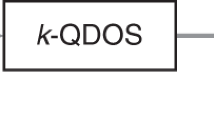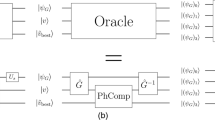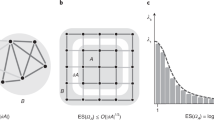Abstract
The density matrix renormalization group method has been extensively used to study the ground state of 1D many-body systems since its introduction two decades ago. In spite of its wide use, this heuristic method is known to fail in certain cases and no certifiably correct implementation is known, leaving researchers faced with an ever-growing toolbox of heuristics, none of which is guaranteed to succeed. Here we develop a polynomial time algorithm that provably finds the ground state of any 1D quantum system described by a gapped local Hamiltonian with constant ground-state energy. The algorithm is based on a framework that combines recently discovered structural features of gapped 1D systems with an efficient construction of a class of operators called approximate ground-state projections (AGSPs). The combination of these tools yields a method that is guaranteed to succeed in all 1D gapped systems. An AGSP-centric approach may help guide the search for algorithms for more general quantum systems, including for the central challenge of 2D systems, where even heuristic methods have had more limited success.
This is a preview of subscription content, access via your institution
Access options
Subscribe to this journal
Receive 12 print issues and online access
$209.00 per year
only $17.42 per issue
Buy this article
- Purchase on Springer Link
- Instant access to full article PDF
Prices may be subject to local taxes which are calculated during checkout


Similar content being viewed by others
References
Bednorz, J. G. & Müller, K. A. Possible high-t c superconductivity in the Ba–La–Cu–O system. Z. Phys. B 64, 189–193 (1986).
Tsui, D. C., Stormer, H. L. & Gossard, A. C. Two-dimensional magnetotransport in the extreme quantum limit. Phys. Rev. Lett. 48, 1559–1562 (1982).
Laughlin, R. B. Anomalous quantum Hall effect: An incompressible quantum fluid with fractionally charged excitations. Phys. Rev. Lett. 50, 1395–1398 (1983).
Verstraete, F. & Cirac, J. I. Renormalization algorithms for quantum-many body systems in two and higher dimensions. Preprint at http://arXiv.org/abs/cond-mat/0407066 (2004).
Vidal, G. Efficient classical simulation of slightly entangled quantum computations. Phys. Rev. Lett. 91, 147902 (2003).
Verstraete, F., Murg, V. & Cirac, J. I. Matrix product states, projected entangled pair states, and variational renormalization group methods for quantum spin systems. Adv. Phys. 57, 143–224 (2008).
Eisert, J., Cramer, M. & Plenio, M. B. Colloquium. Rev. Mod. Phys. 82, 277–306 (2010).
Hastings, M. B. An area law for one-dimensional quantum systems. J. Stat. Mech. 2007, P08024 (2007).
Wolf, M. M., Verstraete, F., Hastings, M. B. & Cirac, J. I. Area laws in quantum systems: Mutual information and correlations. Phys. Rev. Lett. 100, 070502 (2008).
Molnar, A., Schuch, N., Verstraete, F. & Cirac, J. I. Approximating Gibbs states of local Hamiltonians efficiently with projected entangled pair states. Phys. Rev. B 91, 045138 (2015).
Ge, Y. & Eisert, J. Area laws and approximations of quantum many-body states. Preprint at http://arXiv.org/abs/1411.2995 (2014).
White, S. R. Density matrix formulation for quantum renormalization groups. Phys. Rev. Lett. 69, 2863–2866 (1992).
Schollwöck, U. The density-matrix renormalization group. Rev. Mod. Phys. 77, 259–315 (2005).
Hallberg, K. A. New trends in density matrix renormalization. Adv. Phys. 55, 477–526 (2006).
White, S. Spin gaps in a frustrated Heisenberg model for CaV 4O9 . Phys. Rev. Lett. 77, 3633–3636 (1996).
Hieida, Y. Application of the density matrix renormalization group method to a non-equilibrium problem. J. Phys. Soc. Jpn 67, 369–372 (1998).
White, S. & Scalapino, D. Density matrix renormalization group study of the striped phase in the 2d t–J model. Phys. Rev. Lett. 80, 1272–1275 (1998).
White, S. & Chernyshev, A. Neél order in square and triangular lattice Heisenberg models. Phys. Rev. Lett. 99, 127004 (2007).
Eisert, J. Computational difficulty of global variations in the density matrix renormalization group. Phys. Rev. Lett. 97, 260501 (2006).
White, S. R. Density matrix renormalization group algorithms with a single center site. Phys. Rev. B 72, 180403 (2005).
Arad, I., Landau, Z. & Vazirani, U. Improved one-dimensional area law for frustration-free systems. Phys. Rev. B 85, 195145 (2012).
Kitaev, A. Y., Shen, A. H. & Vyalyi, M. N. Classical and Quantum Computation Vol. 47 (American Mathematical Society, 2002).
Oliveira, R. & Terhal, B. M. The complexity of quantum spin systems on a two-dimensional square lattice. Quantum Inf. Comput. 8, 900–924 (2008).
Aharonov, D., Gottesman, D., Irani, S. & Kempe, J. The power of quantum systems on a line. Commun. Math. Phys. 287, 41–65 (2009).
Gottesman, D. & Irani, S. The quantum and classical complexity of translationally invariant tiling and hamiltonian problems. Theory Comput. 9, 31–116 (2013).
Schuch, N., Cirac, I. & Verstraete, F. Computational difficulty of finding matrix product ground states. Phys. Rev. Lett. 100, 250501 (2008).
Arad, I., Kitaev, A., Landau, Z. & Vazirani, U. Proc. 4th Innov. Theor. Comput. Sci. (ITCS) (ACM, 2013).
Aharonov, D., Arad, I. & Irani, S. Efficient algorithm for approximating one-dimensional ground states. Phys. Rev. A 82, 012315 (2010).
Schuch, N. & Cirac, J. I. Matrix product state and mean-field solutions for one-dimensional systems can be found efficiently. Phys. Rev. A 82, 012314 (2010).
Vidal, G. Classical simulation of infinite-size quantum lattice systems in one spatial dimension. Phys. Rev. Lett. 98, 070201 (2007).
Corboz, P., Rice, T. M. & Troyer, M. Competing states in the t–j model: Uniform d-wave state versus stripe state. Phys. Rev. Lett. 113, 046402 (2014).
Jordan, J., Orús, R., Vidal, G., Verstraete, F. & Cirac, J. I. Classical simulation of infinite-size quantum lattice systems in two spatial dimensions. Phys. Rev. Lett. 101, 250602 (2008).
Corboz, P., Orús, R., Bauer, B. & Vidal, G. Simulation of strongly correlated fermions in two spatial dimensions with fermionic projected entangled-pair states. Phys. Rev. B 81, 165104 (2010).
Kraus, C. V., Schuch, N., Verstraete, F. & Cirac, J. I. Fermionic projected entangled pair states. Phys. Rev. A 81, 052338 (2010).
Barthel, T., Pineda, C. & Eisert, J. Contraction of fermionic operator circuits and the simulation of strongly correlated fermions. Phys. Rev. A 80, 042333 (2009).
Pineda, C., Barthel, T. & Eisert, J. Unitary circuits for strongly correlated fermions. Phys. Rev. A 81, 050303 (2010).
Shi, Q-Q., Li, S-H., Zhao, J-H. & Zhou, H-Q. Graded projected entangled-pair state representations and an algorithm for translationally invariant strongly correlated electronic systems on infinite-size lattices in two spatial dimensions. Preprint at http://arXiv.org/abs/0907.5520 (2009).
Corboz, P. & Vidal, G. Fermionic multiscale entanglement renormalization ansatz. Phys. Rev. B 80, 165129 (2009).
Pižorn, I. & Verstraete, F. Fermionic implementation of projected entangled pair states algorithm. Phys. Rev. B 81, 245110 (2010).
Verstraete, F., Wolf, M. M., Perez-Garcia, D. & Cirac, J. I. Criticality, the area law, and the computational power of projected entangled pair states. Phys. Rev. Lett. 96, 220601 (2006).
Schuch, N., Wolf, M. M., Verstraete, F. & Cirac, J. I. Computational complexity of projected entangled pair states. Phys. Rev. Lett. 98, 140506 (2007).
Schuch, N., Pérez-García, D. & Cirac, I. Classifying quantum phases using matrix product states and projected entangled pair states. Phys. Rev. B 84, 165139 (2011).
Perez-Garcia, D., Verstraete, F., Wolf, M. M. & Cirac, J. I. Peps as unique ground states of local hamiltonians. Quantum Inf. Comput. 8, 650–663 (2008).
Cirac, J. I., Poilblanc, D., Schuch, N. & Verstraete, F. Entanglement spectrum and boundary theories with projected entangled-pair states. Phys. Rev. B 83, 245134 (2011).
Acknowledgements
The first two authors acknowledge support by ARO Grant W911NF-12-1-0541, NSF Grant CCF-0905626 and Templeton Foundation Grant 21674. The third author was supported by the National Science Foundation under Grant No. 0844626 and by the Ministry of Education, Singapore under the Tier 3 grant MOE2012-T3-1-009.
Author information
Authors and Affiliations
Contributions
All authors contributed equally to this work.
Corresponding author
Ethics declarations
Competing interests
The authors declare no competing financial interests.
Supplementary information
Supplementary Information
Supplementary Information (PDF 305 kb)
Rights and permissions
About this article
Cite this article
Landau, Z., Vazirani, U. & Vidick, T. A polynomial time algorithm for the ground state of one-dimensional gapped local Hamiltonians. Nature Phys 11, 566–569 (2015). https://doi.org/10.1038/nphys3345
Received:
Accepted:
Published:
Issue Date:
DOI: https://doi.org/10.1038/nphys3345
This article is cited by
-
Contextuality in infinite one-dimensional translation-invariant local Hamiltonians
npj Quantum Information (2022)
-
Entanglement spread area law in gapped ground states
Nature Physics (2022)
-
Entanglement Subvolume Law for 2D Frustration-Free Spin Systems
Communications in Mathematical Physics (2022)
-
On the closedness and geometry of tensor network state sets
Letters in Mathematical Physics (2022)
-
Correlation Length in Random MPS and PEPS
Annales Henri Poincaré (2022)



